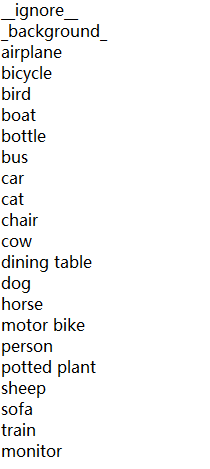自己的数据集由json转为voc数据集
开发环境:python3.7
下面以pascal voc2012为例进行演示:
1.修改 json_to_dataset.py,这个文件在解析json文件的时候会用到;
json_to_dataset.py路径为:/home/xxx/anaconda3/envs/labelme/lib/python3.7/site-packages/labelme/cli
修改:
// json_to_dataset.py
import argparse
import base64
import json
import os
import os.path as osp
import imgviz
import PIL.Image
from labelme.logger import logger
from labelme import utils
def main():
logger.warning(
"This script is aimed to demonstrate how to convert the "
"JSON file to a single image dataset."
)
logger.warning(
"It won't handle multiple JSON files to generate a "
"real-use dataset."
)
parser = argparse.ArgumentParser()
parser.add_argument("json_file")
parser.add_argument("-o", "--out", default=None)
args = parser.parse_args()
json_file = args.json_file
if args.out is None:
out_dir = osp.basename(json_file).replace(".", "_")
out_dir = osp.join(osp.dirname(json_file), out_dir)
else:
out_dir = args.out
if not osp.exists(out_dir):
os.mkdir(out_dir)
data = json.load(open(json_file))
imageData = data.get("imageData")
if not imageData:
imagePath = os.path.join(os.path.dirname(json_file), data["imagePath"])
with open(imagePath, "rb") as f:
imageData = f.read()
imageData = base64.b64encode(imageData).decode("utf-8")
img = utils.img_b64_to_arr(imageData)
label_name_to_value = {
"_background_": 0, "airplane": 1, "bicycle": 2, "bird": 3, "boat": 4, "bottle": 5, "bus": 6, "car": 7, "cat": 8, "chair": 9, "cow": 10, "dining table": 11, "dog":12, "horse": 13, "motor bike": 14, "person": 15, "potted plant": 16, "sheep": 17, "sofa": 18. "train": 19, "monitor": 20 } # 添加指定标签对应的标签值
#注释下面代码
#for shape in sorted(data["shapes"], key=lambda x: x["label"]):
# label_name = shape["label"]
# if label_name in label_name_to_value:
# label_value = label_name_to_value[label_name]
# else:
# label_value = len(label_name_to_value)
# label_name_to_value[label_name] = label_value
lbl, _ = utils.shapes_to_label(
img.shape, data["shapes"], label_name_to_value
)
label_names = [None] * (max(label_name_to_value.values()) + 1)
for name, value in label_name_to_value.items():
label_names[value] = name
lbl_viz = imgviz.label2rgb(
label=lbl, img=imgviz.asgray(img), label_names=label_names, loc="rb"
)
PIL.Image.fromarray(img).save(osp.join(out_dir, "img.png"))
utils.lblsave(osp.join(out_dir, "label.png"), lbl)
PIL.Image.fromarray(lbl_viz).save(osp.join(out_dir, "label_viz.png"))
with open(osp.join(out_dir, "label_names.txt"), "w") as f:
for lbl_name in label_names:
f.write(lbl_name + "\n")
logger.info("Saved to: {}".format(out_dir))
if __name__ == "__main__":
main()
2.修改 label.py 文件
label.py路径:/home/xxx/anaconda3/envs/labelme/lib/python3.7/site-packages/imgviz
修改:
// label.py
import numpy as np
from . import color as color_module
from . import draw as draw_module
def label_colormap(n_label=256, value=None):
"""Label colormap.
Parameters
----------
n_labels: int
Number of labels (default: 256).
value: float or int
Value scale or value of label color in HSV space.
Returns
-------
cmap: numpy.ndarray, (N, 3), numpy.uint8
Label id to colormap.
"""
def bitget(byteval, idx):
return (byteval & (1 << idx)) != 0
cmap = np.zeros((n_label, 3), dtype=np.uint8)
for i in range(0, n_label):
id = i
r, g, b = 0, 0, 0
for j in range(0, 8):
r = np.bitwise_or(r, (bitget(id, 0) << 7 - j))
g = np.bitwise_or(g, (bitget(id, 1) << 7 - j))
b = np.bitwise_or(b, (bitget(id, 2) << 7 - j))
id = id >> 3
cmap[i, 0] = r
cmap[i, 1] = g
cmap[i, 2] = b
#添加自己的colormap
cmap[1,:]=[128,0,0] #airplane
cmap[2,:]=[0,128,0] #bicycle
cmap[3,:]=[128,128,0] #bird
cmap[4,:]=[0,0,128] #boat
cmap[5,:]=[128,0,128] #bottle
cmap[6,:]=[0,128,128] #bus
cmap[7,:]=[128,128,128] #car
cmap[8,:]=[64,0,0] #cat
cmap[9,:]=[192,0,0] #chair
cmap[10,:]=[64,128,0] #cow
cmap[11,:]=[192,128,0] #dining table
cmap[12,:]=[64,0,128] #dog
cmap[13,:]=[192,128,0] #horse
cmap[14,:]=[64,128,128] #motor bike
cmap[15,:]=[192,128,128] #person
cmap[16,:]=[0,64,0] #potted plant
cmap[17,:]=[128,64,0] #sheep
cmap[18,:]=[0,192,0] #sofa
cmap[19,:]=[128,192,0] #train
cmap[20,:]=[0,64,128] #monitor
if value is not None:
hsv = color_module.rgb2hsv(cmap.reshape(1, -1, 3))
if isinstance(value, float):
hsv[:, 1:, 2] = hsv[:, 1:, 2].astype(float) * value
else:
assert isinstance(value, int)
hsv[:, 1:, 2] = value
cmap = color_module.hsv2rgb(hsv).reshape(-1, 3)
return cmap
cmap的值要跟 json_to_dataset.py 中的label_name_to_value对应
3.之后,新建文件夹,在新建文件夹下,将自己的数据(原始图片和对应的json文件)放入同一个 data_annotated 文件夹;之后,制作自己的 labels.txt,拷贝 labelme2voc.py 文件不需改动;准备情况如下:

labels.txt内容如下(类别顺序与 json_to_dataset.py 和 label.py 一致):

labelme2voc.py 文件目录 /labelme/examples/semantic_segmentation 下载链接,因为只用到该文件,大家可以不用去githup下载,这里直接给出 labelme2voc.py :
// labelme2voc.py
#!/usr/bin/env python
from __future__ import print_function
import argparse
import glob
import json
import os
import os.path as osp
import sys
import imgviz
import numpy as np
import PIL.Image
import labelme
def main():
parser = argparse.ArgumentParser(
formatter_class=argparse.ArgumentDefaultsHelpFormatter
)
parser.add_argument('input_dir', help='input annotated directory')
parser.add_argument('output_dir', help='output dataset directory')
parser.add_argument('--labels', help='labels file', required=True)
parser.add_argument(
'--noviz', help='no visualization', action='store_true'
)
args = parser.parse_args()
if osp.exists(args.output_dir):
print('Output directory already exists:', args.output_dir)
sys.exit(1)
os.makedirs(args.output_dir)
os.makedirs(osp.join(args.output_dir, 'JPEGImages'))
os.makedirs(osp.join(args.output_dir, 'SegmentationClass'))
os.makedirs(osp.join(args.output_dir, 'SegmentationClassPNG'))
if not args.noviz:
os.makedirs(
osp.join(args.output_dir, 'SegmentationClassVisualization')
)
print('Creating dataset:', args.output_dir)
class_names = []
class_name_to_id = {
}
for i, line in enumerate(open(args.labels).readlines()):
class_id = i - 1 # starts with -1
class_name = line.strip()
class_name_to_id[class_name] = class_id
if class_id == -1:
assert class_name == '__ignore__'
continue
elif class_id == 0:
assert class_name == '_background_'
class_names.append(class_name)
class_names = tuple(class_names)
print('class_names:', class_names)
out_class_names_file = osp.join(args.output_dir, 'class_names.txt')
with open(out_class_names_file, 'w') as f:
f.writelines('\n'.join(class_names))
print('Saved class_names:', out_class_names_file)
for label_file in glob.glob(osp.join(args.input_dir, '*.json')):
print('Generating dataset from:', label_file)
with open(label_file) as f:
base = osp.splitext(osp.basename(label_file))[0]
out_img_file = osp.join(
args.output_dir, 'JPEGImages', base + '.jpg')
out_lbl_file = osp.join(
args.output_dir, 'SegmentationClass', base + '.npy')
out_png_file = osp.join(
args.output_dir, 'SegmentationClassPNG', base + '.png')
if not args.noviz:
out_viz_file = osp.join(
args.output_dir,
'SegmentationClassVisualization',
base + '.jpg',
)
data = json.load(f)
img_file = osp.join(osp.dirname(label_file), data['imagePath'])
img = np.asarray(PIL.Image.open(img_file))
PIL.Image.fromarray(img).save(out_img_file)
lbl = labelme.utils.shapes_to_label(
img_shape=img.shape,
shapes=data['shapes'],
label_name_to_value=class_name_to_id,
)
labelme.utils.lblsave(out_png_file, lbl)
np.save(out_lbl_file, lbl)
if not args.noviz:
viz = imgviz.label2rgb(
label=lbl,
img=imgviz.rgb2gray(img),
font_size=15,
label_names=class_names,
loc='rb',
)
imgviz.io.imsave(out_viz_file, viz)
if __name__ == '__main__':
main()
最后,在新建文件夹下打开终端,激活labelme虚拟环境,运行:
python labelme2voc.py data_annotated data_dataset_voc --labels labels.txt
JPEGImages存放原图
SegmentationClass存放ground truth(mask)的二进制文件
SegmentationClassPNG存放原图对应的ground truth(mask)
SegmentationClassVisualization存放原图与ground truth融合后的图
感谢各位读者朋友指正
